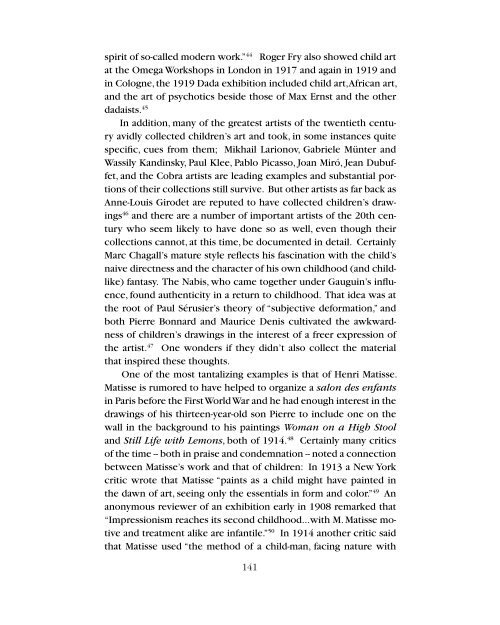Jonathan Fineberg – The Postman Did It – Children’s Art and the Avant-garde
Excerpt from “A Kid Could Do That!”, an extensive publication prepared by Galerie Gmurzynska on the occasion of the large-scale eponymous exhibition project at Art Basel Miami Beach 2014, conceived with Hollywood luminaries Baz Luhrmann and Catherine Martin.
Excerpt from “A Kid Could Do That!”, an extensive publication prepared by Galerie Gmurzynska on the occasion of the large-scale eponymous exhibition project at Art Basel Miami Beach 2014, conceived with Hollywood luminaries Baz Luhrmann and Catherine Martin.
- No tags were found...
You also want an ePaper? Increase the reach of your titles
YUMPU automatically turns print PDFs into web optimized ePapers that Google loves.
spirit of so-called modern work.” 44 Roger Fry also showed child art<br />
at <strong>the</strong> Omega Workshops in London in 1917 <strong>and</strong> again in 1919 <strong>and</strong><br />
in Cologne, <strong>the</strong> 1919 Dada exhibition included child art, African art,<br />
<strong>and</strong> <strong>the</strong> art of psychotics beside those of Max Ernst <strong>and</strong> <strong>the</strong> o<strong>the</strong>r<br />
dadaists. 45<br />
In addition, many of <strong>the</strong> greatest artists of <strong>the</strong> twentieth century<br />
avidly collected children’s art <strong>and</strong> took, in some instances quite<br />
specific, cues from <strong>the</strong>m; Mikhail Larionov, Gabriele Münter <strong>and</strong><br />
Wassily K<strong>and</strong>insky, Paul Klee, Pablo Picasso, Joan Miró, Jean Dubuffet,<br />
<strong>and</strong> <strong>the</strong> Cobra artists are leading examples <strong>and</strong> substantial portions<br />
of <strong>the</strong>ir collections still survive. But o<strong>the</strong>r artists as far back as<br />
Anne-Louis Girodet are reputed to have collected children’s drawings<br />
46 <strong>and</strong> <strong>the</strong>re are a number of important artists of <strong>the</strong> 20th century<br />
who seem likely to have done so as well, even though <strong>the</strong>ir<br />
collections cannot, at this time, be documented in detail. Certainly<br />
Marc Chagall’s mature style reflects his fascination with <strong>the</strong> child’s<br />
naive directness <strong>and</strong> <strong>the</strong> character of his own childhood (<strong>and</strong> childlike)<br />
fantasy. The Nabis, who came toge<strong>the</strong>r under Gauguin’s influence,<br />
found au<strong>the</strong>nticity in a return to childhood. That idea was at<br />
<strong>the</strong> root of Paul Sérusier’s <strong>the</strong>ory of “subjective deformation,” <strong>and</strong><br />
both Pierre Bonnard <strong>and</strong> Maurice Denis cultivated <strong>the</strong> awkwardness<br />
of children’s drawings in <strong>the</strong> interest of a freer expression of<br />
<strong>the</strong> artist. 47 One wonders if <strong>the</strong>y didn’t also collect <strong>the</strong> material<br />
that inspired <strong>the</strong>se thoughts.<br />
One of <strong>the</strong> most tantalizing examples is that of Henri Matisse.<br />
Matisse is rumored to have helped to organize a salon des enfants<br />
in Paris before <strong>the</strong> First World War <strong>and</strong> he had enough interest in <strong>the</strong><br />
drawings of his thirteen-year-old son Pierre to include one on <strong>the</strong><br />
wall in <strong>the</strong> background to his paintings Woman on a High Stool<br />
<strong>and</strong> Still Life with Lemons, both of 1914. 48 Certainly many critics<br />
of <strong>the</strong> time -- both in praise <strong>and</strong> condemnation -- noted a connection<br />
between Matisse’s work <strong>and</strong> that of children: In 1913 a New York<br />
critic wrote that Matisse “paints as a child might have painted in<br />
<strong>the</strong> dawn of art, seeing only <strong>the</strong> essentials in form <strong>and</strong> color.” 49 An<br />
anonymous reviewer of an exhibition early in 1908 remarked that<br />
“Impressionism reaches its second childhood...with M. Matisse motive<br />
<strong>and</strong> treatment alike are infantile.” 50 In 1914 ano<strong>the</strong>r critic said<br />
that Matisse used “<strong>the</strong> method of a child-man, facing nature with<br />
141

















